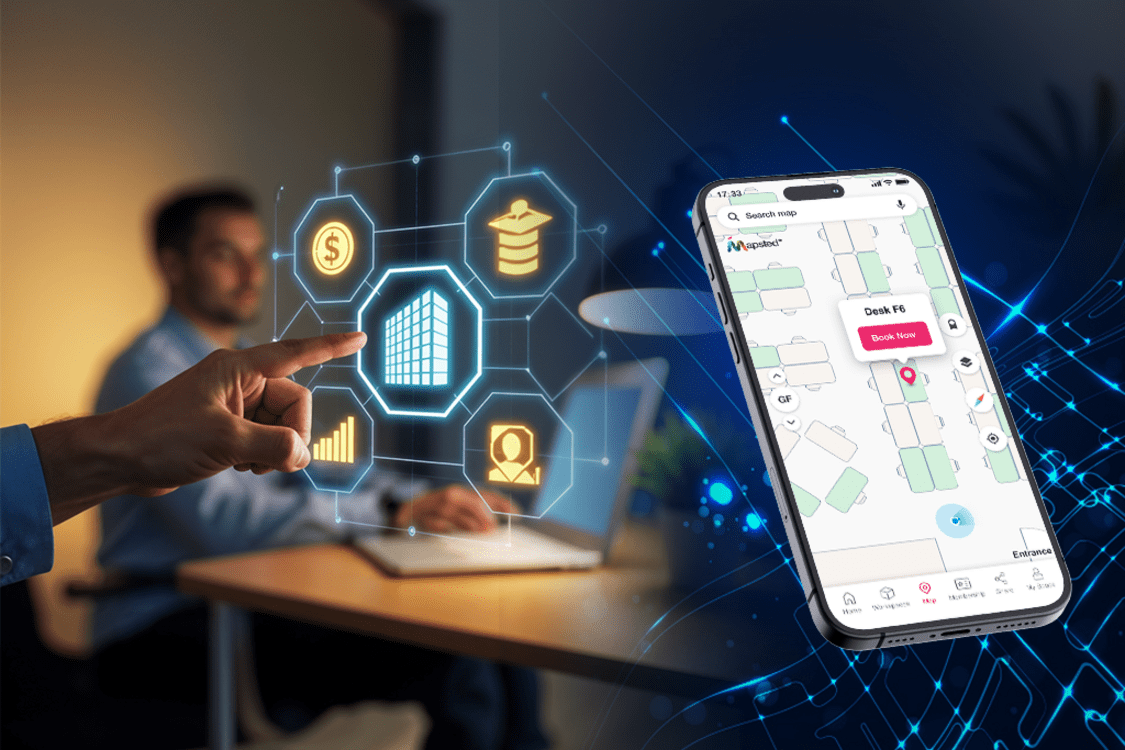Technology Trends

Indoor GPS isn’t just a convenience anymore, it’s becoming core infrastructure in smart buildings. From energy savings and real-time navigation to safety and operational efficiency, indoor location technology is quietly reshaping how modern facilities work. At Mapsted, we have seen how precise, hardware-free indoor positioning can transform everyday operations without disrupting existing infrastructure. Here’s a closer look at how location technology improves Smart building management system and fuels the next era of building intelligence.
What Is Indoor Location Technology?
Indoor location technology, sometimes part of a real-time locating system (RTLS), tracks the position of people and assets inside a building using systems like Wi-Fi, Bluetooth Low Energy (BLE), Ultra-Wideband (UWB) or AI-powered smartphone sensors.
It feeds location data into smart building management system or platforms, enabling them to automate lighting, HVAC, safety and space usage based on real-time presence, not just schedules or motion sensors.


Why it matters: Unlike GPS, which doesn’t work well indoors, this tech gives facility managers live insights into occupancy and movement patterns down to zones, rooms or even desks.
Energy Savings Through Occupancy-Aware Automation
Traditional systems waste energy by running on fixed schedules. Location-aware systems only activate resources like lighting or heating when people are present.
Real-world impact:
- Smart building technology with occupancy data improves energy efficiency by up to 30%
- Buildings using intelligent sensors and controls save an average of 8–18% on energy costs
- In industrial or large retail settings, adjusting lighting and HVAC based on foot traffic leads to leaner, more sustainable operations.
Bonus: These systems also improve occupant comfort by creating the right environment, at the right time, in the right space.
Indoor Navigation Enhances the Occupant Experience
In large buildings of hospitals, offices, campuses and malls, finding your way around can be frustrating. Indoor navigation solves this.
Map-based apps with turn-by-turn directions help employees, visitors or patients locate rooms, meeting areas or amenities instantly. Users can also view live occupancy to avoid crowded areas.
Why it matters:
- Reduces lost time and confusion in large or multi-floor spaces.
- Improves productivity by guiding users directly to available meeting rooms or zones.
- Builds a smoother visitor experience and better brand impression.
Added benefit: Occupants can share their live location with colleagues or friends for easier coordination in complex spaces. These are key benefits of indoor navigation in smart buildings, enhancing both efficiency and satisfaction.
Smarter Space Planning with Real-Time Data
With hybrid work and fluctuating occupancy, real estate usage is evolving fast. Many buildings today are only partially utilized but still fully powered and staffed.
Location-based services in buildings help identify:
- Underused desks, floors or zones.
- Peak traffic times for specific areas.
- Patterns that suggest opportunities to consolidate space.
Data shows:
- 50% + of office seats sit vacant on average, as per multiple industry reports.
- Even at peak times, 45% of space often goes unused.
- Organizations optimizing real estate using occupancy data can save up to 70% on operating costs over 3 years.
In action: Facility managers can close off unused zones, sublease excess space or redesign layouts to match real-world behaviour, not assumptions.
Emergency Response That’s Faster and Smarter
In emergencies, every second counts. Indoor location technology adds speed and precision to safety procedures:
- Live maps guide occupants to the nearest safe exit, avoiding blocked paths.
- Security or first responders can track who’s still inside and where.
- Panic buttons or emergency alerts can share exact locations instantly.
Location-based services in buildings, like geofencing, can trigger alerts if someone enters a restricted or hazardous zone.
Operational Efficiency You Can See
Day-to-day tasks like maintenance, cleaning and asset tracking get faster and more efficient when paired with location insights.
Use cases include:
- Maintenance tickets are tagged with precise coordinates.
- Cleaning routes based on actual foot traffic, not fixed schedules.
- Staff and asset locations are displayed in real time on centralized dashboards.
Result: Faster service, fewer wasted steps and better coordination between teams from IT to security to facilities.
In hospitals, factories or airports, this means less time searching for equipment and more time getting work done.
What’s New: AI, 5G and Digital Twins
The smart building landscape is evolving rapidly. Here are a few trends defining the next chapter:
- AI and ML are being used to predict room demand, optimize HVAC preemptively and improve location accuracy.
- 5G and UWB allow for 1–5 meter accuracy indoors, enabling fine-grained optimizations.
- Digital twins replicate physical spaces in virtual models where live location data can be visualized for planning and remote management.
- Open API ecosystems let indoor location tech integrate with workplace apps, scheduling tools and maintenance software.
Built-in privacy controls and secure data handling ensure occupants’ trust while keeping systems compliant.
Why Location Tech Is No Longer Optional
For building owners, developers and facility managers, indoor location technology is not a “nice-to-have”; it’s a differentiator.
When you can:
- Save on energy,
- Improve occupant satisfaction,
- Optimize space,
- Strengthen safety,
- and Streamline operations
…your building doesn’t just function. It performs.
Mapsted’s indoor positioning platform delivers all this without the need for beacons, wearables or complex installations. Our hardware-free system is scalable, accurate and built for real-world performance.
Whether you manage a hospital, campus, office tower or retail destination, Mapsted helps your building think ahead.
Final Takeaway
Smart buildings aren’t just about tech. They are about people.
What are the benefits of smart building technology? With indoor location services, your space becomes intuitive, responding in real time to how people move, gather and work. Whether you are saving kilowatts, square feet or seconds during emergencies, location technology is the key to unlocking smarter, safer and more responsive environments.
And with a platform like Mapsted’s, you don’t have to start from scratch, you just have to start smart. If you found this blog helpful, please read our blog on Use Cases and Benefits of Location Services in Smart Buildings Or watch our video on Mapsted – Empowering Every Step with Intelligent Navigation to learn more.
Frequently Asked Questions
Q1. What is indoor location technology and how does it work in smart buildings?
Ans. Indoor location technology uses Wi-Fi, BLE, UWB or smartphone sensors to track people and assets inside a building. This real-time data feeds into building systems to optimize operations like lighting, HVAC, safety and navigation.
Q2. How does location technology help reduce energy costs?
Ans. By monitoring real-time occupancy, building systems can automatically adjust HVAC and lighting only where people are present, improving energy efficiency by up to 30%, a key example of how location technology improves smart building management system.
Q3. Can indoor navigation improve employee productivity?
Ans. Predictive maintenance, smart scheduling, content generation, voice assistants, meeting summaries, logistics routing and more.
Q4. Is indoor location tracking secure and private?
Ans. Modern platforms include built-in privacy features such as opt-in tracking, data encryption and role-based access to ensure compliance and trust.
Q5. What makes Mapsted’s solution different from others?
Ans. Mapsted offers a hardware-free indoor positioning platform that doesn’t rely on beacons or wearables, making it more scalable, cost-effective and easier to deploy across multiple building types.

